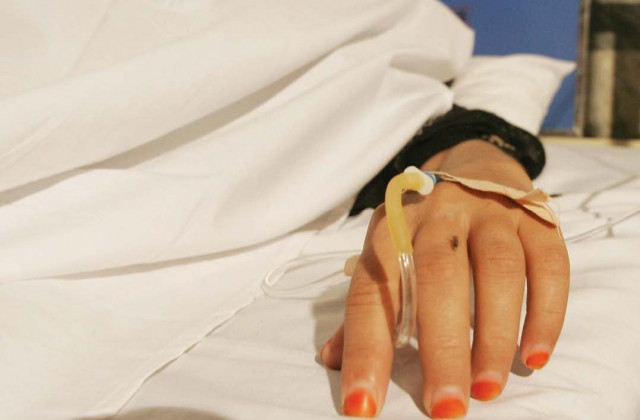
One in 50,000 women in Karachi’s south zone has breast cancer, according to the statistics compiled by the Karachi Cancer Registry.
Breast cancer is the most prevalent cancer among women in the country, however, figures on a national level are difficult to authenticate as the country has no official cancer registry. Rough yet educated estimates by experts put the number of people who annually “fall victim” to cancer in Pakistan at 150,000.
“In Pakistan, we are prone to all sorts of environmental factors and chemicals that are have proved to have a correlation in the development of cancer,” says Dr Neelam Siddiqui, a consultant medical oncologist at the Shaukat Khanum Memorial Cancer Hospital and Research Centre. With 20 years of experience in the field, Siddiqui has dealt with numerous cases. She says, citing World Health Organisation studies, more than 70 per cent of all cancer-related deaths occur in low and middle-income countries.
While it is still not known exactly why a certain individual develops cancer, some successful research and breakthroughs have been made. “What causes cancer and who can get it is a question still unanswered for the most part. The disease doesn’t discriminate, anyone at any age, of any ethnicity or race can develop cancer,” says Dr Siddiqui.
Cancers common in men
According to hepatologist and gastroenterologist at Patel Hospital and a visiting consultant and professor at Civil Hospital, Karachi, Dr Saad Khalid Niaz, the most common cancer in Pakistani men is of the head and neck, followed closely by lung cancer, which is directly related to the consumption of nicotine via smoking, chewing tobacco and eating gutka. On the other hand, consumption of alcohol, which has considerably picked up pace in the country from locally manufactured options to imported labels, has augmented damage to the liver, pancreas and other related organs.
Shaukat Khanum’s Siddiqui explains, “[It’s] true that not everyone who smokes and drinks develops cancer. There are other factors such as family history, age and environment which play a role. But it is safe to say that most people who smoke are liable to develop complications.”
Professor Javaid Khan, consultant chest physician at the Aga Khan University Hospital, adds that shisha or tobacco for hookahs has more carcinogens than many other products.
The AKUH conducted a study to measure the increasing use of shisha among students in the city, taking a sample of 432 students from FAST, DUHS, AKU and CBM.
The study found out that around 43 per cent of the male students and 11 per cent of the females smoked shisha habitually.
Experts say that once the oral cavity, voice box, food pipe and other related organs are affected, it is all downhill from there.
In the later stages, when the cancer is incurable, Dr Saad Niaz says the doctors can offer “palliative care” or control of the symptoms and discomfort of the patient, “essentially easing them in the time they have left.”
Treatment options
“Just like every cancer is not the same, their treatments also differ,” Niaz says, adding that at present, cancer is treated by doctors as “a multi-disciplined management strategy (MDMS)”.
The MDMS applies for most people who have a cancer that can still be treated. This comprises a panel of experts who treat the tumour or cancer each from their own area of expertise: diagnostics, radiation (radiotherapy), chemotherapy and surgery. “Any one of the above can be suitable for one patient but not for another. In some cases you need to use multiple strategies to combat the disease,” Niaz explains.
Dangerous professions
The AKU’s Masood says that among other known chemicals that can play a role in the development of cancer are aniline dyes used in leather tanning factories which are a common cause of kidney and urinary organ cancers. Shaukat Khanum’s Siddiqui adds that a chemical element radon used in building materials at construction sites have also been linked to cancer in the lungs while exposure to benzene is one of the known causes behind leukaemia.
Siddiqui also mentions that workers at rubber factories are running the risk of developing a cancer of the bladder. Further, the lack of control of pesticide use is a serious cause of concern for experts. “Worldwide, especially in the West, the use of certain pesticides is strictly prohibited as they are carcinogenic,” Siddiqui says. “But in Pakistan they are widely used to maintain and grow crops, which are then consumed by the public.”
All three experts spoke on hepatitis being a prime cause of concern as types B and C of the virus are especially linked to liver cancer. On the other hand, there are some reports which remain unproved. “The development of cancer through the use of hair spray, microwave, cellular phone and plastic bottles remain largely anecdotal,” Masood says.
Additional reporting by Samia Saleem
Leading causes of cancer:
Tobacco
Alcohol
Obesity
Physical inactivity
Human papilloma virus (HPV)
Source: Professor Javaid Khan, Consultant Chest Physician at the Aga Khan University Hospital
Improved diet and early screening:
Eat whole grain and include more lentils in your diet
Avoid animal fats
Strict control of weight, obesity can lead to multiple problems
Increase physical activity
After the age of 50, women need to get annual mammograms
Screening for cervical cancer (girls and women)
Published in The Express Tribune, February 4th, 2011.


















COMMENTS
Comments are moderated and generally will be posted if they are on-topic and not abusive.
For more information, please see our Comments FAQ